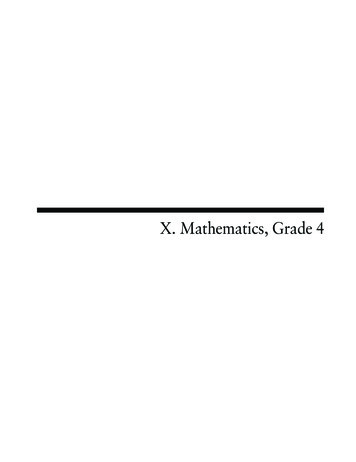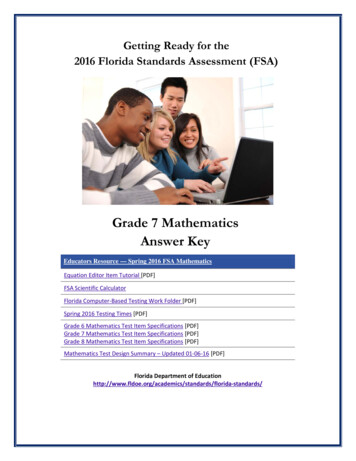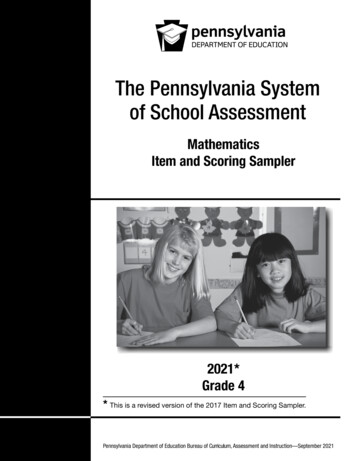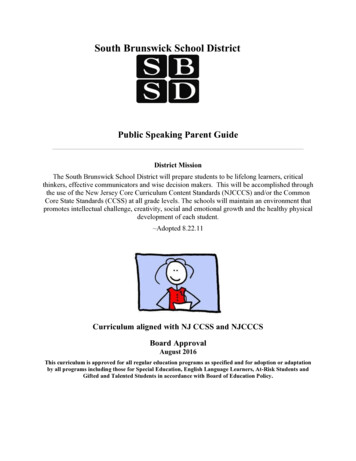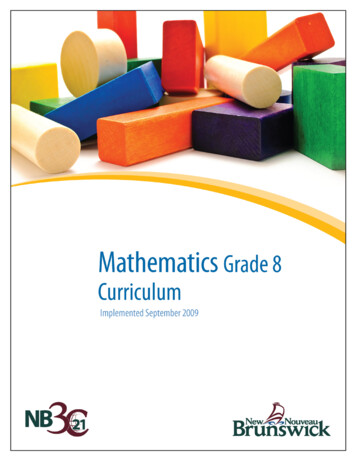
Transcription
1
AcknowledgementsThe Department of Education of New Brunswick gratefully acknowledges the contributions of thefollowing groups and individuals toward the development of the New Brunswick Grade 8 MathematicsCurriculum Guide: The Western and Northern Canadian Protocol (WNCP) for Collaboration in Education: The CommonCurriculum Framework for K-9 Mathematics, May 2006. Reproduced (and/or adapted) by permission.All rights reserved. Alberta Education (Department of Education) Newfoundland and Labrador Department of Education Prince Edward Island Department of Education The Middle Level Mathematics Curriculum Development Advisory Committee The Grade 8 Curriculum Development Team: Angela Buggie, School District 16Kim Clancy, School District 6Craig Crawford, School District 15Derrick Grant, School District 18Elizabeth Nowlan, School District 2Erin Schriver, School District 14 Cathy Martin, Learning Specialist, K-8 Mathematics and Science, NB Department of Education The Mathematics Learning Specialists, Numeracy Leads, and Mathematics teachers of NewBrunswick who provided invaluable input and feedback throughout the development andimplementation of this document.2009Department of EducationEducational Programs and ServicesAdditional copies of this document may be obtained using the Title Code: 844480
Table of ContentsCurriculum Overview for K-9 MathematicsBackground and Rationale. 2Beliefs about Students and Mathematics Learning. 2Goals for Mathematically Literate Students . 3Opportunities for Success . 3Diverse Cultural Perspectives . 4Adapting to the Needs of All Learners . 4Connections Across the Curriculum. 4Assessment . 5Conceptual Framework for K – 9 Mathematics . 6Mathematical Processes . 7Communication . 7Connections . 7Reasoning . 7Mental Mathematics and Estimation . 8Problem Solving . 8Technology. 9Visualization . 9Nature of Mathematics . 10Change . 10Constancy . 10Number Sense . 10Relationships. 10Patterns . 11Spatial Sense . 11Uncertainty . 11Structure of the Mathematics Curriculum . 12Curriculum Document Format . 13Specific Curriculum Outcomes . 14Number . 14Patterns and Relations . 42Shape and Space. 50Statistics and Probability . 74Appendix A: Glossary of Models . 82Appendix B: List of Grade 8 Specific Curriculum Outcomes . 89Appendix C: References. 90NEW BRUNSWICK MATHEMATICS GRADE 8 CURRICULUM GUIDEPage 1
CURRICULUM OVERVIEW FOR K – 9 MATHEMATICSBACKGROUND AND RATIONALEMathematics curriculum is shaped by a vision which fosters the development of mathematicallyliterate students who can extend and apply their learning and who are effective participants insociety.It is essential the mathematics curriculum reflects current research in mathematics instruction.To achieve this goal, the Western and Northern Canadian Protocol (WNCP) CommonCurriculum Framework for K-9 Mathematics (2006) has been adopted as the basis for a revisedmathematics curriculum in New Brunswick. The Common Curriculum Framework wasdeveloped by the seven ministries of education (Alberta, British Columbia, Manitoba, NorthwestTerritories, Nunavut, Saskatchewan and Yukon Territory) in collaboration with teachers,administrators, parents, business representatives, post-secondary educators and others. Theframework identifies beliefs about mathematics, general and specific student outcomes, andachievement indicators agreed upon by the seven jurisdictions. This document is based on bothnational and international research by the WNCP and the NCTM.There is an emphasis in the New Brunswick curriculum on particular key concepts at eachgrade which will result in greater depth of understanding and ultimately stronger studentachievement. There is also a greater emphasis on number sense and operations concepts inthe early grades to ensure students develop a solid foundation in numeracy.The intent of this document is to clearly communicate high expectations for students inmathematics education to all education partners. Because of the emphasis placed on keyconcepts at each grade level, time needs to be taken to ensure mastery of these concepts.Students must learn mathematics with understanding, actively building new knowledge fromexperience and prior knowledge (NCTM Principles and Standards, 2000).BELIEFS ABOUT STUDENTS AND MATHEMATICS LEARNINGThe New Brunswick Mathematics Curriculum is based upon several key assumptions or beliefsabout mathematics learning which have grown out of research and practice. These beliefsinclude: mathematics learning is an active and constructive process; learners are individuals who bring a wide range of prior knowledge and experiences, andwho learn via various styles and at different rates; learning is most likely to occur when placed in meaningful contexts and in an environmentthat supports exploration, risk taking, and critical thinking and that nurtures positiveattitudes and sustained effort; and learning is most effective when standards of expectation are made clear with on-goingassessment and feedback.Students are curious, active learners with individual interests, abilities and needs. They come toclassrooms with varying knowledge, life experiences and backgrounds. A key component insuccessfully developing numeracy is making connections to these backgrounds andexperiences.Students develop a variety of mathematical ideas before they enter school. Children makesense of their environment through observations and interactions at home and in thecommunity. Mathematics learning is embedded in everyday activities, such as playing, reading,storytelling and helping around the home. Such activities can contribute to the development ofnumber and spatial sense in children. Curiosity about mathematics is fostered when children arePage 2NEW BRUNSWICK MATHEMATICS GRADE 8 CURRICULUM GUIDE
CURRICULUM OVERVIEW FOR K – 9 MATHEMATICSengaged in activities such as comparing quantities, searching for patterns, sorting objects,ordering objects, creating designs, building with blocks and talking about these activities.Positive early experiences in mathematics are as critical to child development as are earlyliteracy experiences.Students learn by attaching meaning to what they do and need to construct their own meaningof mathematics. This meaning is best developed when learners encounter mathematicalexperiences that proceed from the simple to the complex and from the concrete to the abstract.The use of models and a variety of pedagogical approaches can address the diversity oflearning styles and developmental stages of students, and enhance the formation of sound,transferable, mathematical concepts. At all levels, students benefit from working with andtranslating through a variety of materials, tools and contexts when constructing meaning aboutnew mathematical ideas. Meaningful discussions can provide essential links among concrete,pictorial and symbolic representations of mathematics.The learning environment should value and respect all students’ experiences and ways ofthinking, so that learners are comfortable taking intellectual risks, asking questions and posingconjectures. Students need to explore problem-solving situations in order to develop personalstrategies and become mathematically literate. Learners must realize that it is acceptable tosolve problems in different ways and that solutions may vary.GOALS FOR MATHEMATICALLY LITERATE STUDENTSThe main goals of mathematics education are to prepare students to: use mathematics confidently to solve problems communicate and reason mathematically appreciate and value mathematics make connections between mathematics and its applications commit themselves to lifelong learning become mathematically literate adults, using mathematics to contribute to society.Students who have met these goals will: gain understanding and appreciation of the contributions of mathematics as a science,philosophy and art exhibit a positive attitude toward mathematics engage and persevere in mathematical tasks and projects contribute to mathematical discussions take risks in performing mathematical tasks exhibit curiosityOPPORTUNITIES FOR SUCCESSA positive attitude has a profound effect on learning. Environments that create a sense ofbelonging, encourage risk taking, and provide opportunities for success help develop andmaintain positive attitudes and self-confidence. Students with positive attitudes toward learningmathematics are likely to be motivated and prepared to learn, participate willingly in classroomactivities, persist in challenging situations and engage in reflective practices. Teachers, studentsand parents need to recognize the relationship between the affective and cognitive domains,and attempt to nurture those aspects of the affective domain that contribute to positive attitudes.To experience success, students must be taught to set achievable goals and assessthemselves as they work toward these goals. Striving toward success, and becomingautonomous and responsible learners are ongoing, reflective processes that involve revisitingthe setting and assessing of personal goals.NEW BRUNSWICK MATHEMATICS GRADE 8 CURRICULUM GUIDEPage 3
CURRICULUM OVERVIEW FOR K – 9 MATHEMATICSDIVERSE CULTURAL PERSPECTIVESStudents attend schools in a variety of settings including urban, rural and isolated communities.Teachers need to understand the diversity of cultures and experiences of all students.Aboriginal students often have a whole-world view of the environment in which they live andlearn best in a holistic way. This means that students look for connections in learning and learnbest when mathematics is contextualized and not taught as discrete components. Aboriginalstudents come from cultures where learning takes place through active participation.Traditionally, little emphasis was placed upon the written word. Oral communication along withpractical applications and experiences are important to student learning and understanding. It isalso vital that teachers understand and respond to non-verbal cues so that student learning andmathematical understanding are optimized. It is important to note that these generalinstructional strategies may not apply to all students.A variety of teaching and assessment strategies is required to build upon the diverseknowledge, cultures, communication styles, skills, attitudes, experiences and learning styles ofstudents. The strategies used must go beyond the incidental inclusion of topics and objectsunique to a culture or region, and strive to achieve higher levels of multicultural education(Banks and Banks, 1993).ADAPTING TO THE NEEDS OF ALL LEARNERSTeachers must adapt instruction to accommodate differences in student development as theyenter school and as they progress, but they must also avoid gender and cultural biases. Ideally,every student should find his/her learning opportunities maximized in the mathematicsclassroom. The reality of individual student differences must not be ignored when makinginstructional decisions.As well, teachers must understand and design instruction to accommodate differences instudent learning styles. Different instructional modes are clearly appropriate, for example, forthose students who are primarily visual learners versus those who learn best by doing.Designing classroom activities to support a variety of learning styles must also be reflected inassessment strategies.CONNECTIONS ACROSS THE CURRICULUMThe teacher should take advantage of the various opportunities available to integratemathematics and other subjects. This integration not only serves to show students howmathematics is used in daily life, but it helps strengthen the students’ understanding ofmathematical concepts and provides them with opportunities to practise mathematical skills.There are many possibilities for integrating mathematics in literacy, science, social studies,music, art, and physical education.Page 4NEW BRUNSWICK MATHEMATICS GRADE 8 CURRICULUM GUIDE
CURRICULUM OVERVIEW FOR K – 9 MATHEMATICSASSESSMENTOngoing, interactive assessment (formative assessment) is essential to effective teaching andlearning. Research has shown that formative assessment practices produce significant andoften substantial learning gains, close achievement gaps and build students’ ability to learn newskills (Black & William, 1998, OECD, 2006). Student involvement in assessment promoteslearning. Interactive assessment, and encouraging self-assessment, allows students to reflecton and articulate their understanding of mathematical concepts and ideas.Assessment in the classroom includes: providing clear goals, targets and learning outcomes using exemplars, rubrics and models to help clarify outcomes and identify importantfeatures of the work monitoring progress towards outcomes and providing feedback as necessary encouraging self-assessment fostering a classroom environment where conversations about learning take place,where students can check their thinking and performance and develop a deeperunderstanding of their learning (Davies, 2000)Formative assessment practices act as the scaffolding for learning which, only then, can bemeasured through summative assessment. Summative assessment, or assessment of learning,tracks student progress, informs instructional programming and aids in decision making. Bothforms of assessment are necessary to guide teaching, stimulate learning and produceachievement gains.Student assessment should: align with curriculum outcomes use clear and helpful criteria promote student involvement in learning mathematics during and after the assessmentexperience use a wide variety of assessment strategies and tools yield useful information to inform instruction(adapted from: NCTM, Mathematics Assessment: A practical handbook, 2001, p.22)Work Samples Rubricsmath journalsportfoliosdrawings, charts, tables and graphsindividual and classroom assessmentpencil-and-paper tests constructed responsegeneric rubricstask-specific rubricsquestioningObservationsSurveys attitude interest parent questionnairesAssessing MathematicsDevelopment in aBalanced MannerSelf-AssessmentMath Conferences personal reflection andevaluation individualgroupteacher-initiatedchild-initiated planned (formal)unplanned (informal)read aloud (literature with math focus)shared and guided math activitiesperformance tasksindividual conferencesanecdotal recordschecklistsinteractive activitiesNEW BRUNSWICK MATHEMATICS GRADE 8 CURRICULUM GUIDEPage 5
CURRICULUM OVERVIEW FOR K – 9 MATHEMATICSCONCEPTUAL FRAMEWORK FOR K – 9 MATHEMATICSThe chart below provides an overview of how mathematical processes and the nature ofmathematics influence learning outcomes.GRADEK123456789STRANDNumberPatterns and Relations Patterns Variables and EquationsGENERAL OUTCOMESShape and Space Measurement 3-D Objects and 2-D shapes TransformationsSPECIFIC OUTCOMESACHIEVEMENT INDICATORSStatistics and Probability Data Analysis Chance and r SensePatternsRelationshipsSpatial SenseUncertaintyMATHEMATICAL PROCESSES – COMMUNICATION, CONNECTIONS,REASONING, MENTAL MATHEMATICSAND ESTIMATION, PROBLEM SOLVING,TECHNOLOGY, VISUALIZATIONINSTRUCTIONAL FOCUSThe New Brunswick Curriculum is arranged into four strands. These strands are not intended tobe discrete units of instruction. The integration of outcomes across strands makes mathematicalexperiences meaningful. Students should make the connection between concepts both withinand across strands. Consider the following when planning for instruction: Integration of the mathematical processes within each strand is expected. By decreasing emphasis on rote calculation, drill and practice, and the size of numbers usedin paper and pencil calculations, more time is available for concept development. Problem solving, reasoning and connections are vital to increasing mathematical fluency, andmust be integrated throughout the program. There is to be a balance among mental mathematics and estimation, paper and pencilexercises, and the use of technology, including calculators and computers. Concepts shouldbe introduced using models and gradually developed from the concrete to the pictorial to thesymbolic. There is a greater emphasis on mastery of specific curriculum outcomes.The mathematics curriculum describes the nature of mathematics, mathematical processes andthe mathematical concepts to be addressed. The components are not meant to stand alone.Activities that take place in the mathematics classroom should stem from a problem-solvingapproach, be based on mathematical processes and lead students to an understanding of thenature of mathematics through specific knowledge, skills and attitudes among and betweenstrands.Page 6NEW BRUNSWICK MATHEMATICS GRADE 8 CURRICULUM GUIDE
CURRICULUM OVERVIEW FOR K – 9 MATHEMATICSMATHEMATICAL PROCESSESThere are critical components that students must encounter in a mathematics program in orderto achieve the goals of mathematics education and encourage lifelong learning in mathematics.Students are expected to: communicate in order to learn and express their understanding of mathematics(Communications: C) connect mathematical ideas to other concepts in mathematics, to everyday experiences andto other disciplines (Connections: CN) demonstrate fluency with mental mathematics and estimation (Mental Mathematics andEstimation: ME) develop and apply new mathematical knowledge through problem solving (Problem Solving:PS) develop mathematical reasoning (Reasoning: R) select and use technologies as tools for learning and solving problems (Technology: T) develop visualization skills to assist in processing information, making connections andsolving problems (Visualization: V).The New Brunswick Curriculum incorporates these seven interrelated mathematical processesthat are intended to permeate teaching and learning.Communication [C]Students need opportunities to read about, represent, view, write about, listen to and discussmathematical ideas. These opportunities allow students to create links between their ownlanguage and ideas, and the formal language and symbols of mathematics. Communication isimportant in clarifying, reinforcing and modifying ideas, knowledge, attitudes and beliefs aboutmathematics. Students should be encouraged to use a variety of forms of communication whilelearning mathematics. Students also need to communicate their learning using mathematicalterminology. Communication can help students make connections among concrete, pictorial,symbolic, verbal, written and mental representations of mathematical ideas.Connections [CN]Contextualization and making connections to the experiences of learners are powerfulprocesses in developing mathematical understanding. When mathematical ideas are connectedto each other or to real-world phenomena, students can begin to view mathematics as useful,relevant and integrated. Learning mathematics within contexts and making connections relevantto learners can validate past experiences, and increase student willingness to participate and beactively engaged. The brain is constantly looking for and making connections.“Because the learner is constantly searching for connections on many levels, educators need toorchestrate the experiences from which learners extract understanding Brain researchestablishes and confirms that multiple complex and concrete experiences are essential formeaningful learning and teaching” (Caine and Caine, 1991, p. 5).Reasoning [R]Mathematical reasoning helps students think logically and make sense of mathematics.Students need to develop confidence in their abilities to reason and justify their mathematicalthinking. High-order questions challenge students to think and develop a sense of wonder aboutmathematics. Mathematical experiences in and out of the classroom provide opportunities forinductive and deductive reasoning. Inductive reasoning occurs when students explore andrecord results, analyze observations, make generalizations from patterns and test theseNEW BRUNSWICK MATHEMATICS GRADE 8 CURRICULUM GUIDEPage 7
CURRICULUM OVERVIEW FOR K – 9 MATHEMATICSgeneralizations. Deductive reasoning occurs when students reach new conclusions based uponwhat is already known or assumed to be true.Mental Mathematics and Estimation [ME]Mental mathematics is a combination of cognitive strategies that enhance flexible thinking andnumber sense. It is calculating mentally without the use of external memory aids. Mentalmathematics enables students to determine answers without paper and pencil. It improvescomputational fluency by developing efficiency, accuracy and flexibility. Even more importantthan performing computational procedures or using calculators is the greater facility thatstudents need—more than ever before—with estimation and mental mathematics (NationalCouncil of Teachers of Mathematics, May 2005).Students proficient with mental mathematics “become liberated from calculator dependence,build confidence in doing mathematics, become more flexible thinkers and are more able to usemultiple approaches to problem solving” (Rubenstein, 2001). Mental mathematics “provides acornerstone for all estimation processes offering a variety of alternate algorithms and nonstandard techniques for finding answers” (Hope, 1988).Estimation is a strategy for determining approximate values or quantities, usually by referring tobenchmarks or using referents, or for determining the reasonableness of calculated values.Students need to know how, when and what strategy to use when estimating. Estimation isused to make mathematical judgments and develop useful, efficient strategies for dealing withsituations in daily life.Students need to develop both mental mathematics and estimation skills through context andnot in isolation so they are able to apply them to solve problems. Whenever a problem requiresa calculation, students should follow the decision making process as described below.Problem SituationCalculation RequiredApproximateAnswer AppropriateExact AnswerNeededUse MentalCalculationUse Paperand PencilUse aCalculator/ComputerEstimate(NCTM)Problem Solving [PS]Learning through problem solving should be the focus of mathematics at all grade levels. Whenstudents encounter new situations and respond to questions of the type, “How would you.?" or“How could you.?” the problem-solving approach is being modeled. Students develop their ownproblem-solving strategies by being open to listening, discussing and trying different strategies.Page 8NEW BRUNSWICK MATHEMATICS GRADE 8 CURRICULUM GUIDE
CURRICULUM OVERVIEW FOR K – 9 MATHEMATICSIn order for an activity to be problem-solving based, it must ask students to determine a way toget from what is known to what is sought. If students have already been given ways to solve theproblem, it is not a problem, but practice. A true problem requires students to use prior learningin new ways and contexts. Problem solving requires and builds depth of conceptualunderstanding and student engagement.Problem solving is also a powerful teaching tool that fosters multiple, creative and innovativesolutions. Creating an environment where students openly look for and engage in finding avariety of strategies for solving problems empowers students to explore alternatives anddevelops confident, cognitive, mathematical risk takers.Technology [T]Technology contributes to the learning of a wide range of mathematical outcomes and enablesstudents to explore and create patterns, examine relationships, test conjectures and solveproblems.Calculators and computers can be used to: explore and demonstrate mathematical relationships and patterns organize and display data extrapolate and interpolate assist with calculation procedures as part of solving problems decrease the time spent on computations when other mathematical learning is the focus reinforce the learning of basic facts and test properties develop personal procedures for mathematical operations create geometric displays simulate situations develop number sense.Technology contributes to a learning environment in which the growing curiosity of students canlead to rich mathematical discoveries at all grade levels. While technology can be used in K–3to enrich learning, it is expected that students will meet all outcomes without the use oftechnology.Visualization [V]Visualization “involves thinking in pictures and images, and the ability to perceive, transform andrecreate different aspects of the visual-spatial world” (Armstrong, 1993, p. 10). The use ofvisualization in the study of mathematics provides students with opportunities to understandmathematical concepts and make connections among them. Visual images and visualreasoning are important components of number, spatial and measurement sense. Numbervisualization occurs when students create mental representations of numbers.Being able to create, interpret and describe a visual representation is part of spatial sense andspatial reasoning. Spatial visualization and reasoning enable students to describe therelationships among and between 3-D objects and 2-D shapes.Measurement visualization goes beyond the acquisition of specific measurement skills.Measurement sense includes the ability to determine when to measure, when to estimate and toknow several estimation strategies (Shaw & Cliatt, 1989).Visualization is fostered through the use of concrete materials, technology and a variety ofvisual representations.NEW BRUNSWICK MATHEMATICS GRADE 8 CURRICULUM GUIDEPage 9
CURRICULUM OVERVIEW FOR K – 9 MATHEMATICSNATURE OF MATHEMATICSMathematics is one way of trying to understand, interpret and describe our world. There are anumber of components that define the nature of mathematics and these are woven throughoutthis document. These components include: change, constancy, number sense,relationships, patterns, spatial sense and uncertainty.ChangeIt is important for students to understand that mathematics is dynamic and not static. As aresult, recognizing change is a key component in understanding and developing mathematics.Within mathematics, students encounter conditions of change and are required to search forexplanations of that change. To make predictions, students need to describe and quantify theirobservations, look for patterns, and describe those quantities that remain fixed and those thatchange. For example, the sequence 4, 6, 8, 10, 12, can be described as: skip counting by 2s, starting from 4 an arithmetic sequence, with first term 4 and a common difference of 2 a linear function with a discrete domain(Steen, 1990, p. 184).ConstancyDifferent aspects of constancy are described by the terms stability, conservation, equilibrium,steady state and symmetry (AAAS–Benchmarks, 1993, p. 270). Many important properties inmathematics and science relate to properties that do not change when outside conditionschange. Examples of constancy include: the area of a rectangular region is the same regardless of the methods used to determine thesolution the
It is essential the mathematics curriculum reflects current research in mathematics instruction. To achieve this goal, the Western and Northern Canadian Protocol (WNCP) Common Curriculum Framework for K-9 Mathematics (2006) has been adopted as the bas






